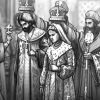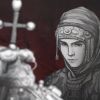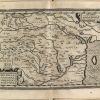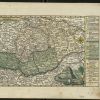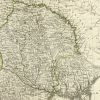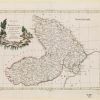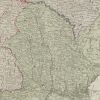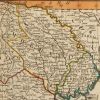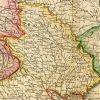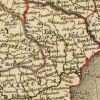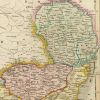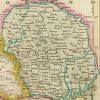 71880
71880
History of Moldova (brief outline)
1. The Moldavians are the descendants of an ancient folk that inhabited the territory from the South Carpathians to the Bug river thousands of years ago. The culture, discovered by archaeologists in late 19th and 20th centuries, was formed by this folk in 6-3 millennium BC and was called the Cucuteni-Tripoli Culture. Descendants of this great folk are the founders of many European and Middle Eastern civilizations, including the civilization of Ancient Rome. In the 2nd and 1st millennium BC linear descendants of the Cucuteni folk became known to historians as the Thracians.
2. The Thracians was a multitudinous and large folk, which inhabited the Balkan Peninsula, including the area between the Dniester and Prut rivers, as well as lived in Asia Minor (Anatolian Peninsula). The Anatolian Thracians formed western part of the Hittite Empire population, which occupied the territory of modern Turkey and part of the Middle East. During the whole 2nd millennium BC Hittite Empire was the main rival of Egypt in their strife for the influence in the Middle East and the Mediterranean.
3. The Thracians had numerous public formations and structures, which were mentioned by Homer in his works and in ancient Eastern historical texts as well. According to the Greek historian Herodotus, who lived in the 5th century BC, "After the Indians, the Thracians is the most abundant folk on the Earth. If the Thracians were only more unanimous and consentient under the reign of a strong lord, they would have been unconquerable and more powerful than others". Such an assessment could have been given to a folk not only numerous, but also the one with a great material and spiritual culture.
4. The Getaes (Goths), according to Herodotus, are "... the most brave and honest among all Thracians…who consider themselves to be immortal". This is a numerous the Thracian folk, which, as all Thracians, spoke Indo-European language of "Centum" language group (proto-Latin). The Sarmatians (Sauromates) , or as they have been also called “Indo-Europeans”, is one of the proto-Slavs folk branches, natives of Mesopotamia and Ancient Iran territories, which migrated across the Central Asia, the Urals, the Volga, the Northern Black Sea coast to territories of the Dniester and the Danube rivers during 2-1 millenniums BC. Together with a part of the western Sarmatians, the Getaes created the State of Dacia, the inhabitants of which were called the Dacians.
5. Dacia was the state, which existed during 300 - 500 years starting from the 4th-2nd centuries BC and finishing with the year 106 AC. The Kingdom of Dacia was built as a union of two folks, the Goths and Sarmatians, what was reflected in the name of the state capital - Sarmisegethusa (Sarmis-E-Geth-Usa). Throughout the history of Dacia, the Thracian (Getaes) element assimilated the Sarmatians (pro-Slavs), who were the residents of the same State with the Goths, absorbing some of elements from the Sarmatian (proto-Slavs) language and culture.
6. Throughout its long history, the Kingdom of Dacia has been a powerful state located in a large area northward of the Danube river. The state has its own well-developed economic, culture, religion, military and large population.
7. It should be noted that the Dacians, as well as the Thracians, spoke language very close to Latin, since the ancestral home of the Thracians, Italians, Greeks and Celts, who were the native speakers of one common language group, was the territory of the Northern Balkans.
8. In 106 AC, the Roman emperor Trajan conquered a part of Dacia (20-25% of the whole state territory) and its capital Sarmisegethusa. Later the Roman province with the same name (Dacia) was formed on the conquered territory.
9. Trajan devastated the conquered the Central Dacia, taking away enormous wealth from its territory: gold, silver, cultural treasures and valuables of the Dacian royal dynasties, wiped out elites of the state, destroyed the capital of the Kingdom and religious buildings of our ancestors. Trajan brought a plentiful kill from Dacia to Rome to the delight of freeloading on other people's misfortunes “civilized” Roman citizens, who got used to live on handouts of emperors, plundering the conquered peoples.. There was no other victory, which Rome celebrated more widely than a victory over Dacia. In honor of this victory, a hill was removed following the order of Trajan and a huge temple complex was built there, which ruins remain till nowadays, and the famous Trajan's Column, on the surface of which we can see fragments of the war with Dacia.
10. The rush of some historians to heroize the Emperor Trajan, the establishment of our ancestors’ enemy into the rank of a national hero, the desire to ascribe him some good causes is reprehensible and is not supported by the project of www.moldovenii.md. The mindless adoration over this highly controversial personality is so much common that children, streets, wine are named after him! Even the construction of defensive structures on the territory of modern Moldova (the so-called Shaft of Trajan) is attributed to this Emperor, but in real the Shaft has nothing common with Trajan. In fact, these fortifications were built by Moldavians. The proof of this lies in the fact that the largest facility among these fortifications, which stretches from the city of Leov to the city of Bender, runs exactly through the southern border of Moldova of the 16th century, when the south of modern Moldova was captured by the Turks, who formed their own Raya (areas controlled by the Turks) there. The nature of this structure shows that it was built to defend people against attacks from the south, i.e. to protect Moldova from the Turks and Tatars, but not the Romans from “barbarians from North” as some “qualified historians” like to call our ancestors.
11. Other parts of territories of Ancient Dacia were occupied by the so-called “free Dacians”, who constantly made military raids to the Roman possessions reaching the Adriatic coast.
12. Versal legions, recruited in different parts of the Roman Empire like Iberia (modern Spain), Macedonia, Syria and North Africa “stood” and saw active service on the territory of the Roman province of Dacia. Colonists, who were the citizens of Rome, arrived to Dacia from different parts of the Empire, were alike different language spoken and ethnically mixed (from Semites to Gauls). The real number of these colonists is still unknown, but most of such "Romans" spoke poor Latin, so, no doubts, they anyway could not “Romanize” the numerous rural population of Roman Dacia, which lived in mountainous and forest areas, and, of course, far less they could “Romanize” the “free Dacians”. Thus, terms the "Romanians" and "Romanian language" which both appeared in the 19th century as a result of alleged the Roman (Latin) origins of the Moldavians and Vlachs (Romanians), is a completely unfounded and unnecessarily cut off the ancient roots of the Moldavian and modern the Romanian folks, which go deep into the millennial history of the Carpathian-Danube-Dniester area.
13. Veterans-soldiers and colonists, who arrived to the Roman Dacia from different parts of the Empire (from Iberia to North Africa), taking the Dacian women as their wives, have learned the language of the local population – the Dacians, who spoke the pre-Latin and close to the Latin language. Children that were born in such mixed marriages, of course, spoke the language of their mothers and felt themselves the Dacians, there are lots of evidences of that fact in the form of inscriptions on stones, carved by the Roman soldiers-Dacians (in the period from year 120 AC to year 250 AC) in many parts of the former the Roman Empire.
14. In 275 AC under drives and attacks of the “free Dacians” and their allies, Rome finally left the territory of Dacia, pulled back its troops, administration and part of citizens outside of the Danube river. Rural and part of urban residents of the Roman Dacia stayed in their places being united into rural communities. Rural communities, in their turn, had united around cities and towns into small state formations and institutions led by Knezes. Social-state life on the territories occupied by the “free Dacians” followed the similar scheme of formation.
15. By this time the Great Migration of folks had started and the Dacians (which were later called "Walachs" by other nations), being divested of their nationwide political and intellectual elite in result of wars with Rome, had to live during 1000 of years in empires (states) that were controlled and ruled by other folks and nations, such as Goths, Huns, Ostrogoths, Gepids, Avars, Slavs, Hungarians, even forming the greater part of the population (sometimes even the majority) on the territories they inhabited. It is quite likely that even those times our ancestors were called the same name as today – the Moldavians. This version is supported by numerous place-names which are scattered around the Balkans and Central Europe, as well as the Moldavian ballads and legends that were created long time before the Moldavian state was formed.
16. During these years our ancestors, living compactly in ethnic communities in mountains and forests, have preserved their own language and culture standing out by their richness and originality from the surrounding world.
17. In the middle of the 14th century the Walachia governor Dragos, who was the national of the Hungarian King, conquered and occupied with his military troops sparsely populated hilly lands left by the Mongols and Tatars in the Eastern Carpathians. In 1359 the governor Bogdan has formed here the State of Moldova. At the time of the establishment of Moldova as a state, the Walachs (Moldavians) and Slavs, in nearly same proportion, were living on the territory of the future country; the territory was also inhabited by a small amount of the Tatars, Genoese, Jews and people of other nationalities.
18. By the beginning of the 15th century the total area of the territory of Moldova was approximately 100,000 square kilometers. This area stretched from the Carpathian Mountains to the Dniester river, the Danube river and the Black Sea.
19. Cetate Alba (modern Belgorod-Dniester) Seaport and Danube Kealia river port belonged to the state of Moldova. Those times these two ports played an important role for the entire European trade with the Black Sea region, Asia and North Africa. Those times the Moldavian fleet dominated on the Black Sea, was very remarkable and perceptible in the Mediterranean Sea and was built on the Moldavian shipyards.
20. Due to large ports and important international trade routes, which passed through Moldova, the state of Moldova was one of the richest in this part of Europe. There are some well-known cases in the history of Moldova, when the state extended credits to such countries as Poland and Hungary in 14-15th centuries.
21. In 1453 the Turks conquered Constantinople, the Byzantine Empire fell and the Ottoman Empire was founded. The new strong Empire was aggressive, powerful and a death-dealing enemy, however, a prominent the Moldavian ruler Stefan the Great led a successful defensive war with Ottomans. There are well-known historical cases when Stefan won battles with his armies being several times smaller than the Turksish ones.
22. Ottomans did not manage to conquer Moldova. However, in the late 15th century Moldova lost its historic ports, and in the 16th century the state also lost the southern (steppe) part of the modern the Republic of Moldova.
23. Beginning from the late 16th century, Moldova was a state with a strong, sometimes less powerful, vassal dependence from the Turks, having, however, its statehood and independence in matters of internal policy, culture and religion. From time to time the Moldavians upraised against the Turks, trying to gain full independence.
24. In the early 19th century, in a result of the Russian-Turkish wars, Moldova lost the territory between the river Prut and river Dniester (Bessarabia), which was retrograded to Russia (including the seaside part handpicked by Russia from Turkey).
25. During their long history the Moldavians called their language Moldavian and called themselves the Moldavians. As the main evidences of this fact different Moldavian chronicles, documents of the Hospodar’s Office and documents from foreign countries can be named. Many Moldavians who are living in Romania even nowadays do not consider themselves to be the Romanians, but call themselves ethnic Moldavians.
26. How did residents of the neighboring to Moldova Wallachia region (modern Romania districts located around Bucharest) call themselves is still unknown due to fact that this state does not have such a well-described history as the Moldavian nation does. However, it is well-known that Wallachs have never called themselves the Romanians, same as they have never called their language as the Romanian one. At least, until the 19th century.
27. All “Romanian” classical literature of the 19th century is actually the Moldavian one due to fact that it was written by the Moldavian authors in the Moldavian language (Costache Conachi, George Asachi, Constantine Negruzzi, Vasile Alexandri, Alecu Russo, Mihai Eminescu, Ion Creangă, Constantin Stamati Ciurea and others). The language of Moldavian literature of the 19th century became known in Bucharest as the Romanian, and was filled, mostly wrongly, with foreign words.
28. In a result of Moldova association with Wallachia into one state in 1862, Moldova’s statehood was lost after more than 500 years of developing history. The new formation was called Romania contrary to historical truth and bypassing all international agreements. The Moldavians have played an important role in the liberation of the outside the river Prut Moldova and Wallachia regions from the Ottoman yoke, as well as from the excessive protection of the Russian Empire. Our romantically minded young intellectuals and military men played a decisive role in the unification of Moldova and Wallachia. Those were the Moldavians, who understood the importance of association of two fraternal folks into one common state as a necessary condition of preservation. Those were the Moldavians who made a decisive contribution into the ideological, political and military support of this unification. Unfortunately, solving these up to date problems our great compatriots have not paid sufficient attention to the importance of compliance with international agreements about the naming of state and folk emerging as a result of such association. They didn’t mention how they, entirely captivated by the process of association, were ‘bypassed’ by less romantic, but more experienced in political intrigue, more numerous, practical and energetic Walachs, who imposed the name of the nation asthe "Romanians" and the name of the state as "Romania" that were historically alien to our people. Our outstanding compatriots, guided by good motives, fell into the trap from which they didn’t manage to get out and where they also pulled a large part of the Moldavian people. Here it is worth remembering the classic of the Moldavian literature Alecu Russo, who wrote in the 50th years of the 19th century the following lines: “...Poor Stefan Voda, where is he to see...? We are not the Moldavians anymore now but the Romanians…I'm afraid that in a farewell hour when the air tube calls us to the Last Judgment, we will not be able to communicate and understand our ancestors neither by language, nor by the idea...”.
29. Attempts and efforts of the Moldavian nation to resist the complete elimination of the Moldavian statehood culminated with intervention of military units from Bucharest, which cruelly drowned in blood folks’ public speaking in Iasi in 1866.
30. In 1918 on the territory of the Russian province of Bessarabia the Moldavian statehood under the name of the Moldavian Democratic Republic of the RSFSR was re-formed and re-established. New state existed during several months only and was eliminated in a result of the Romanian invasion.
31. In 1924 the Moldavian statehood was again restored: the Moldavian Autonomous Republic which has all attributes and functions of the state (except the possibility of an independent foreign policy) - the government, the flag, the anthem and the national language, was formed as a part of the Ukrainian Soviet Socialist Republic (which, in its turn, was a part of the Soviet Union).
32. In 1940 the MASSR was transformed into the Moldavian SSR (as a part of the Soviet Union), which occupied the territory between the river Prut and river Dniester, and the part of the former MASSR on the left bank of the Dniester river.
33. In 1991 the Moldavian nation regained its independence and an independent state of the Republic of Moldova was formed as a subject of international law .
34. Thus, over the 650-year history of Moldova, the Moldavian folk didn’t have its own statehood during only 62 years.
35. We all know a number of countries (including countries of Europe) with interrupted and then restored statehood, such as Hungary, the Czech Republic, Poland, Finland and so on.
36. Now it can be seen that the Moldavians and Romanians take their origin from single ethnic area and are closely related folks having one literary language, which is properly called the Moldavian language as it was created by the Moldavians. But still the Moldavians and the Romanians differ from each other by attitudes to their own history and origin, if we ignore other smaller differences. The Romanians believe that they are successions of a mixed, different language speaking folk, which once inhabited the Roman province of Dacia, while the Moldavians consider themselves the successors of an ancient nation that inhabited the Carpathian-Dniester area, having lived in this area for more than 8000 years already, having rich culture, history and ancient symbols which they inherited from their ancestries.
Publications
În contextul lansării programului ”Satul European”, ce probleme vitale există în localitatea dumneavoastră?
- Statut:
- Oraș
- Prima atestare:
- 1432
- Populația:
- 14516 locuitori
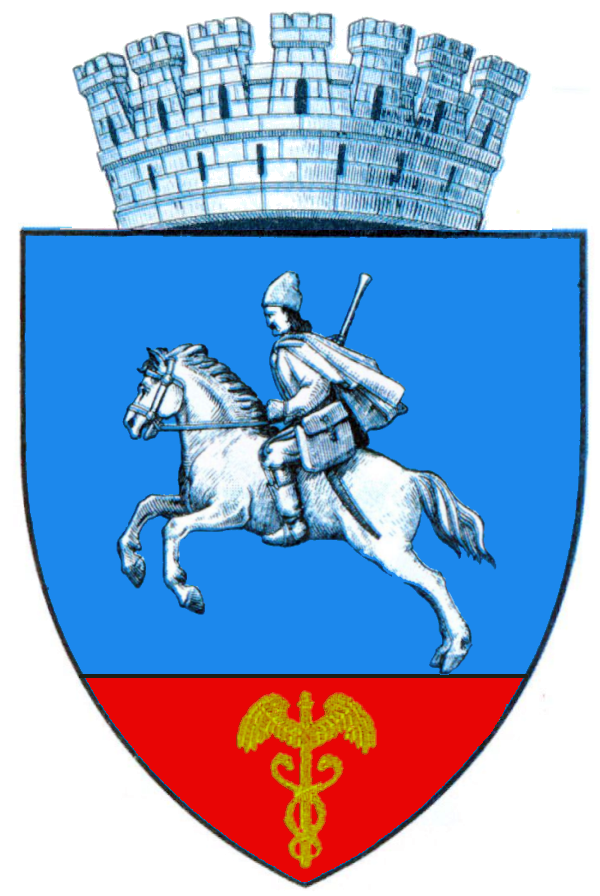
Călăraşi este un oraş din Republica Moldova, centrul administrativ al raionului Călăraşi. Amplasat pe ambele maluri ale rîului Bîc, oraşul Călăraşi este situat la 49 km de Chișinău. Conform datelor recensămîntului din anul 2004, populaţia oraşului constituie 14516 de locuitori. Localitatea a fost atestată documentar cu denumirea de Tuzara la 1432 – 1433, cînd Ilie Vodă dăruia slugii sale Staia „satul Tuzora pe Bîc”.





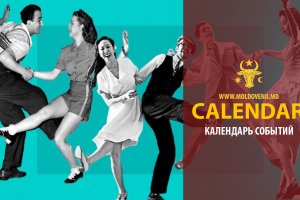 13 aprilie - Calendarul celor mai importante evenimente din trecut și prezent
13 aprilie - Calendarul celor mai importante evenimente din trecut și prezent  MELODIA ZILEI: Alternosfera - Flori de mai
MELODIA ZILEI: Alternosfera - Flori de mai  Ce evenimente culturale vor avea loc în ziua de 13 aprilie
Ce evenimente culturale vor avea loc în ziua de 13 aprilie 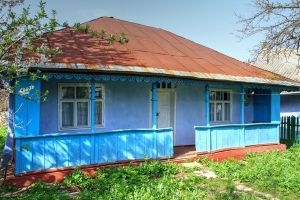 Moldografia: Casă veche, Mănăstirea Cușelăuca, Șoldănești
Moldografia: Casă veche, Mănăstirea Cușelăuca, Șoldănești 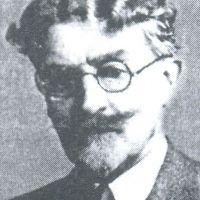 Nicolae Gumalic – 157 de ani de la naștere
Nicolae Gumalic – 157 de ani de la naștere 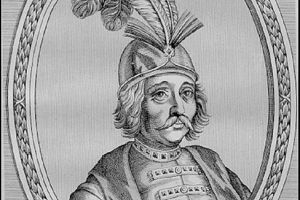 Gheorghe Ștefan – “Om deplin, capu întregu, hire adîncă, cît poţi dzice că nasc…
Gheorghe Ștefan – “Om deplin, capu întregu, hire adîncă, cît poţi dzice că nasc…  Alimentele degresate conțin mai mult zahăr
Alimentele degresate conțin mai mult zahăr  Sucul de lămîie și lumina solară contribuie la dezinfectarea apei potabile
Sucul de lămîie și lumina solară contribuie la dezinfectarea apei potabile  Valeriu Ostalep: Integrarea europeană reală nu înseamnă conversații și întrevede…
Valeriu Ostalep: Integrarea europeană reală nu înseamnă conversații și întrevede…  Cum să fii fericit întreaga zi
Cum să fii fericit întreaga zi 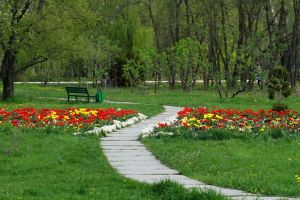 Dendrariul din Chişinău – atracția capitalei (Foto)
Dendrariul din Chişinău – atracția capitalei (Foto)  14 aprilie - Calendarul celor mai importante evenimente din trecut și prezent
14 aprilie - Calendarul celor mai importante evenimente din trecut și prezent 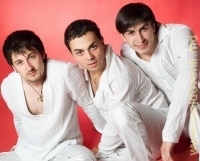 MELODIA ZILEI: Akord - În ochii tăi
MELODIA ZILEI: Akord - În ochii tăi  Ce evenimente culturale vor avea loc în ziua de 14 aprilie
Ce evenimente culturale vor avea loc în ziua de 14 aprilie 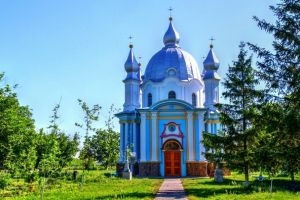 Moldografia: Biserica din satul Cubolta, Sîngerei
Moldografia: Biserica din satul Cubolta, Sîngerei  Vocea poporului: Vor participa cetățenii la recensămîntul populației care se des…
Vocea poporului: Vor participa cetățenii la recensămîntul populației care se des… 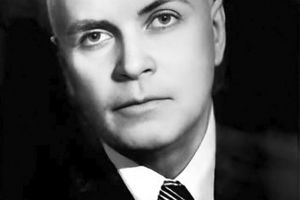 Gheorghe Bezviconi – un erudit în slujba Moldovei
Gheorghe Bezviconi – un erudit în slujba Moldovei 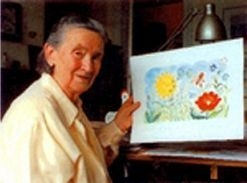 Lumea poveștilor lui Elisabeth Ivanovsky
Lumea poveștilor lui Elisabeth Ivanovsky 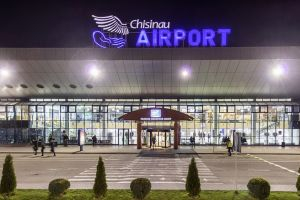 Alte trei companii aeriene vor opera curse de pe Aeroportul Internațional Chișin…
Alte trei companii aeriene vor opera curse de pe Aeroportul Internațional Chișin…  Un pugilist moldovean a ajuns în finala Campionatului European
Un pugilist moldovean a ajuns în finala Campionatului European 